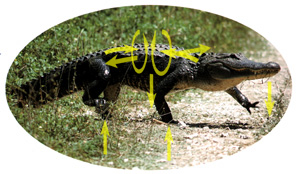Research

Whilst doing my dissertation in Germany I became interested in Konstruktionsmorphologie, a type of biomechanical analysis that is deeply rooted in scientific philosophies that are specific to the German language. Combined with careful dissection work, I came to recognise how, through the application of methods unique to Konstruktionsmorphologie I could interpret the evolutionary significance of a number of anatomical features that diagnose some of the major groups of crocodilians. By looking at the way in which living crocodilians brace their bodies against mechanical loading, I have been able to identify a number of anatomical features that correlate with their locomotor capabilities. I have then used this information to construct biomechanical models for the bracing systems of fossil crocodilians.
Most of my research in this area has focused on the origin of the bracing system that is characteristic of Eusuchia, the taxonomic group that includes all living crocodilians. In particular, I have tried to address the biomechanical transformations that could lead to the evolution of such features as procoelous vertebrae, a tetraserial paravertebral shield and increased flexibility of the neck.

A result of this work has been the realisation that the evolution of crocodilians, particular in terms of their postcranial anatomy, has been strongly canalised, and that multiple transformation sequences can be used to explain the origin of those anatomical features that are characteristic of the eusuchian-type bracing system. A corollary of this has been the realisation that the morphological patterns currently used to classify crocodilians taxonomically may not necessarily provide an insight into evolutionary processes, particularly the way in which certain morphological transformations may have occurred.
I am now interested in using biomechanical transformation models as an independent means by which to evaluate the utility of different evolutionary scenarios, and assess the relevance, particularly in evolutionary terms, of many of the anatomical singularities used in taxonomic diagnoses.
Continued work in this area is being conducted in collaboration with Dr Eberhard ?Dino' Frey and Dr Bernd Herkner.
